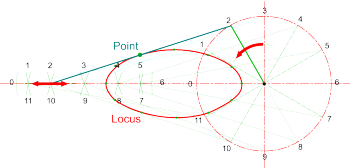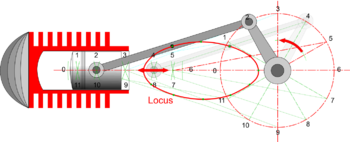Loci: Difference between revisions
From DT Online
(Completed Loci) |
(Added Template) |
||
| Line 1: | Line 1: | ||
__TOC__ | |||
=====Description===== | |||
The [https://en.wikipedia.org/wiki/Locus_%28mathematics%29 '''Locus of a Point'''] is the path traced by a point as it moves in accordance with set conditions and constraints. The plural of [http://www.mathopenref.com/locus.html '''Locus'''] is '''Loci'''. | The [https://en.wikipedia.org/wiki/Locus_%28mathematics%29 '''Locus of a Point'''] is the path traced by a point as it moves in accordance with set conditions and constraints. The plural of [http://www.mathopenref.com/locus.html '''Locus'''] is '''Loci'''. | ||
| Line 7: | Line 12: | ||
More practically it sometimes necessary to know the path traced by the ends of pieces of machinery to check clearances, estimate the velocities at different parts of a linkage ''(perhaps to calculate momentum)'' or to design guarding for example. The general method is to draw the linkage or mechanism in several ‘freeze frame’ positions then draw a smooth curve through the plotted points. | More practically it sometimes necessary to know the path traced by the ends of pieces of machinery to check clearances, estimate the velocities at different parts of a linkage ''(perhaps to calculate momentum)'' or to design guarding for example. The general method is to draw the linkage or mechanism in several ‘freeze frame’ positions then draw a smooth curve through the plotted points. | ||
=====Constructions===== | |||
{| cellpadding="5" | {| cellpadding="5" | ||
| Line 24: | Line 31: | ||
|} | |} | ||
{{Drawing Instruments Buyers Guide}} | |||
Revision as of 19:08, 2 June 2016
Description
The Locus of a Point is the path traced by a point as it moves in accordance with set conditions and constraints. The plural of Locus is Loci.
For example: the locus of all points a set distance from another point is a circle; the locus of all points equi-distant from the ends of a line is the perpendicular bisector of the line; and the locus of all points a set distance from a given line are lines parallel to it (or an oval if the locus continues round the ends of the line)
More practically it sometimes necessary to know the path traced by the ends of pieces of machinery to check clearances, estimate the velocities at different parts of a linkage (perhaps to calculate momentum) or to design guarding for example. The general method is to draw the linkage or mechanism in several ‘freeze frame’ positions then draw a smooth curve through the plotted points.
Constructions
| Plotting Loci on a Crank and Slider Mechanism |
|
|











